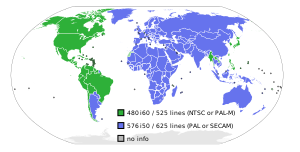This article needs additional citations for verification. (May 2023) |

525-line (or EIA 525/60) is an American standard-definition television resolution used since July 1, 1941,[1][2][3] mainly in the context of analog TV broadcast systems. It consists of a 525-line raster, with 480 lines carrying the visible image at 30 interlaced frames per second. It was eventually adopted by countries using 60 Hz utility frequency as TV broadcasts resumed after World War II. With the introduction of color television in the 1950s,[4] it became associated with the NTSC analog color standard.
The system was given their letter designation as CCIR System M in the ITU identification scheme adopted in Stockholm in 1961.
A similar 625-line system was adopted by countries using 50 Hz utility frequency. Other systems, like 375-line, 405-line, 441-line and 819-line existed, but became outdated or had limited adoption.
The modern standard-definition digital video resolution 480i is equivalent to 525-line and can be used to digitize a TV signal, or to it playback generating a 525-line compatible analog signal.[5]
- ^ Cite error: The named reference
:0was invoked but never defined (see the help page). - ^ Cite error: The named reference
:1was invoked but never defined (see the help page). - ^ Cite error: The named reference
autowas invoked but never defined (see the help page). - ^ National Television System Committee (1951–1953), Report and Reports of Panel No. 11, 11-A, 12–19, with Some supplementary references cited in the Reports, and the Petition for adoption of transmission standards for color television before the Federal Communications Commission, n.p., 1953], 17 v. illus., diagrs., tables. 28 cm. LC Control No.:54021386 Library of Congress Online Catalog
- ^ "What means 480i?". Afterdawn.com.
© MMXXIII Rich X Search. We shall prevail. All rights reserved. Rich X Search
